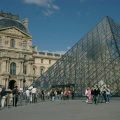Museum housing numerous pieces from Egypt, representing all the Muslim dynasties in Egypt.
Former royal palace, the famous Louvre can boast a very long history. This history began at the end of the 12thcentury . In 1190, King Philip Augustus (1180-1223) had a fortress built outside the city walls of Paris, occupying the southwestern quarter of what is now the Cour Carrée. This building, about 70 to 80 m on each side, was surrounded by ditches while its thick wall was flanked by towers and had only two entrances. In the center, the keep, the large tower that served among other things as a safe and prison. The origin of this massive construction was the imperative need to defend the city, notably by watching over the Seine, a route of invasion used by men from the north, commonly called Vikings, since the Carolingian era. It was during the construction of the Grand Louvre that archaeologists were able to uncover the remains of this first building in the 1980s. Some of these architectural elements are now freely accessible. In fact, by walking through the wide shopping arcades of the Carrousel, you can walk along the old moats, the northeast corner tower, and at the foot of the keep destroyed in 1528. Not far away, in the rooms of the "Medieval Louvre" renovated in 2016, many objects from this period are on display to the public. In the Crypt of Saint Louis, the oldest room in the palace, where the remains of a decoration dating from the reign of Saint Louis (1226-1270) were discovered, one can also see many artifacts testifying to the daily life of the period but also a gilded copper parade helmet that would have belonged to King Charles VI, known as the Fool (1368-1422). In the Model Room, visitors can discover the transformations that have marked the history of the Louvre Palace over the centuries, as well as its decorations, notably those of Jean Goujon (16th century). You can also see the remains of the Tuileries Palace built by Catherine de Medici and destroyed in 1871 during the Paris Commune. With the development of the city in the Middle Ages, the Louvre gradually lost its defensive function. It became a royal residence, notably under Charles V, known as the Wise (1338-1380). However, it was Francis I (1494-1547) who had the defensive keep destroyed and began major transformations. These changes continued until the reign of Charles IX (1550-1574). The west and the south of the medieval enclosure were thus replaced by two elegant wings of Renaissance style. And it was under Henri IV (1553-1610) that the Louvre Palace and the Tuileries Palace were united. The Cour Carrée, designed by the architects Lemercier and Le Vau, dates from the reigns of Louis XIII (1601-1643) and Louis XIV (1638-1715). The palace was also decorated and fitted out in the style of the day, ornaments due to the masters Poussin, Romanelli and Le Brun until Louis XIV decided to install his court in Versailles. After a period of relative abandonment, the Louvre underwent further transformations in the 18th century, and it was at this time that it became a museum. This is a different story, one whose origins lie in the distant past. In the 16th century, King Charles V surrounded himself with works of art, which he kept in the Vincennes dungeon Later, under François I, an important collection was built up in Fontainebleau, in the " Cabinet des tableaux". This cabinet included masterpieces by Italian masters such as Raphael and Michelangelo. These works were kept for their beauty and to further enhance the prestige they brought to the sovereign, an interest that continued from monarch to monarch until the 18thcentury . During this period, known as the "Age of Enlightenment," Diderot suggested that the works in the Louvre be exhibited to the public, following the model of the British Museum opened in 1759. But it was not until 1791 that the Louvre Palace was entirely devoted to the conservation of works of art, and 1793 that a " Museum of the Republic " was created, bringing together former royal collections and confiscated property, which were henceforth available to all. It was thus in November 1793 that the Louvre Palace opened its doors to the public for the first time. In 1981, President François Mitterrand launched the Grand Louvre project, and the architect Pei designed the famous glass pyramid in the Cour du Carrousel, at the crossroads of the galleries to be visited. Today, the museum exhibits collections covering several millennia of history, art, and civilization in a 58,470-square-meter space, divided into eight departments in three wings of the palace: Richelieu, Denon, and Sully. One discovers Egyptian antiquities (mummies, objects of daily life...), Oriental (Assyria, Mesopotamia...) Greek (numerous vases, sculptures, tanagras...), Etruscan and Roman (bronzes, mosaics...), Byzantine and Coptic (fabrics, elements of architecture...), paintings, sculptures, Islamic arts. A total of 35,000 works are on display, including the Mona Lisa,the Victory of Samothrace,the Winged Bulls of Khorsabad, the Raft of the Medusa, the Golden Apollo of Lillebonne, the Coptic Church of Baouit... In addition to the visit (permanent or temporary exhibitions), the Louvre Museum offers various activities (workshops, guided tours...) and conferences in its auditorium
Members' reviews on MUSÉE DU LOUVRE











Difficile à voir la joconde par contre